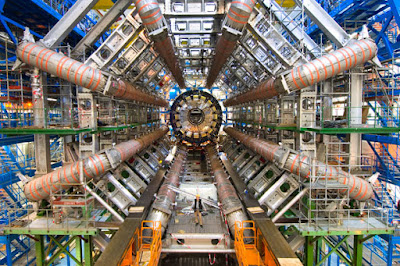At the Heart of All Matter of hunt for the God particle
If you were to dig a hole 300 feet straight down from the center of the charming French village of Crozier, you'd pop into a setting that calls to mind the subterranean lair of one of those James Bond villains. A garishly lit tunnel ten feet in diameter curves away into the distance, interrupted every few miles by lofty chambers crammed with heavy steel structures, cables, pipes, wires, magnets, tubes, shafts, catwalks, and enigmatic gizmos.
This technological netherworld is one very big scientific instrument, specifically, a particle accelerator-an atomic peashooter more powerful than any ever built. It's called the Large Hadron Collider, and its purpose is simple but ambitious: to crack the code of the physical world; to figure out what the universe is made of; in other words, to get to the very bottom of things.
Starting sometime in the coming months, two beams of particles will race in opposite directions around the tunnel, which forms an underground ring 17 miles in circumference. The particles will be guided by more than a thousand cylindrical, supercooled magnets, linked like sausages. At four locations the beams will converge, sending the particles crashing into each other at nearly the speed of light. If all goes right, matter will be transformed by the violent collisions into wads of energy, which will in turn condense back into various intriguing types of particles, some of them never seen before. That's the essence of experimental particle physics: You smash stuff together and see what other stuff comes out.
Those masses of equipment spaced along the tunnel will scrutinize the spray from the collisions. The largest, ATLAS, has a detector that's seven stories tall. The heaviest, CMS (for Compact Muon Solenoid), is heftier than the Eiffel Tower. "Bigger is better if you're searching for smaller" could be the motto at the European Organization for Nuclear Research, better known by its historic acronym CERN, the international laboratory that houses the Large Hadron Collider.
It sounds scary, and it is. Building the LHC in a tunnel was a prudent move. The particle beam could drill a hole in just about anything, although the most likely victim would be the apparatus itself. One minor calamity has already happened: A magnet all but jumped out of its skin during a test in March 2007. Since then 24 magnets have been retrofitted to fix a design flaw. The people running the LHC aren't in a rush to talk about all the things that can go wrong, perhaps because the public has a way of worrying that mad scientists will accidentally create a black hole that devours the Earth.
The more plausible fear is that the collider will fail to find the things that physicists insist must be lurking in the deep substrate of reality. Such a big machine needs to produce big science, big answers, something that can generate a headline as well as interesting particles. But even an endeavor of this scale isn't going to answer all the important questions of matter and energy. Not a chance. This is because a century of particle physics has given us a fundamental truth: Reality doesn't reveal its secrets easily.
Put it this way: The universe is a tough nut to crack.
Go back a little more than a century to the late 1800s, and look at the field of physics: a mature science, and rather complacent. There were those who believed there wasn't much more to do than smooth out some rough edges in nature's plan. There was a sensible order to things, a clockwork universe governed by Newtonian forces, with atoms as the foundation of matter. Atoms were indivisible by definition—the word comes from the Greek for "uncuttable."
But then strange things started popping up in laboratories: x-rays, gamma rays, a mysterious phenomenon called radioactivity. Physicist J. J. Thomson discovered the electron. Atoms were not indivisible after all, but had constituents. Was it, as Thomson believed, a pudding, with electrons embedded like raisins? No. In 1911 physicist Ernest Rutherford announced that atoms are mostly empty space, their mass concentrated in a tiny nucleus orbited by electrons.
Physics underwent one revolution after another. Einstein's special theory of relativity (1905) begat the general theory of relativity (1915), and suddenly even such reliable concepts as absolute space and absolute time had been discarded in favor of a mind-boggling space-time fabric in which two events can never be said to be simultaneous. Matter bends space; space directs how matter moves. Light is both a particle and a wave. Energy and mass are inter- changeable. Reality is probabilistic and not deterministic: Einstein didn't believe that God plays dice with the universe, but that became the scientific orthodoxy.


Comments
Post a Comment